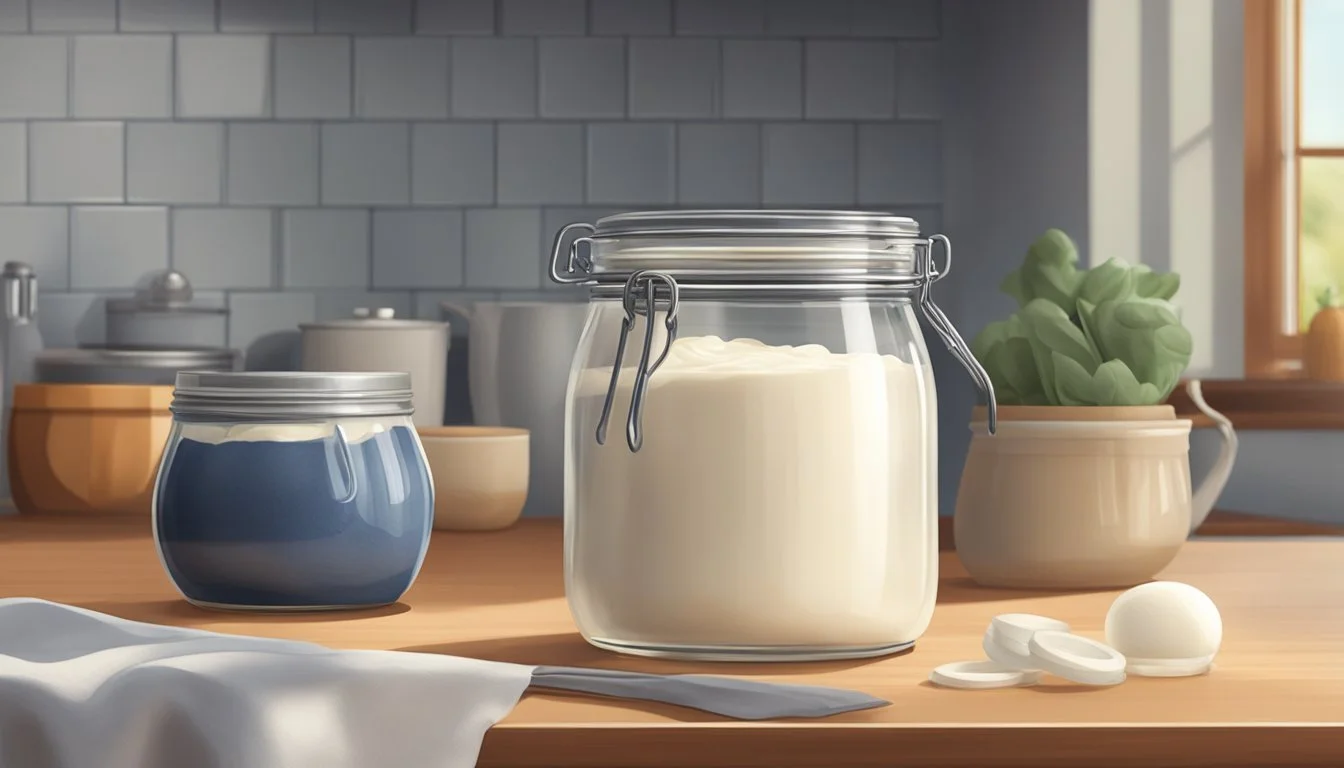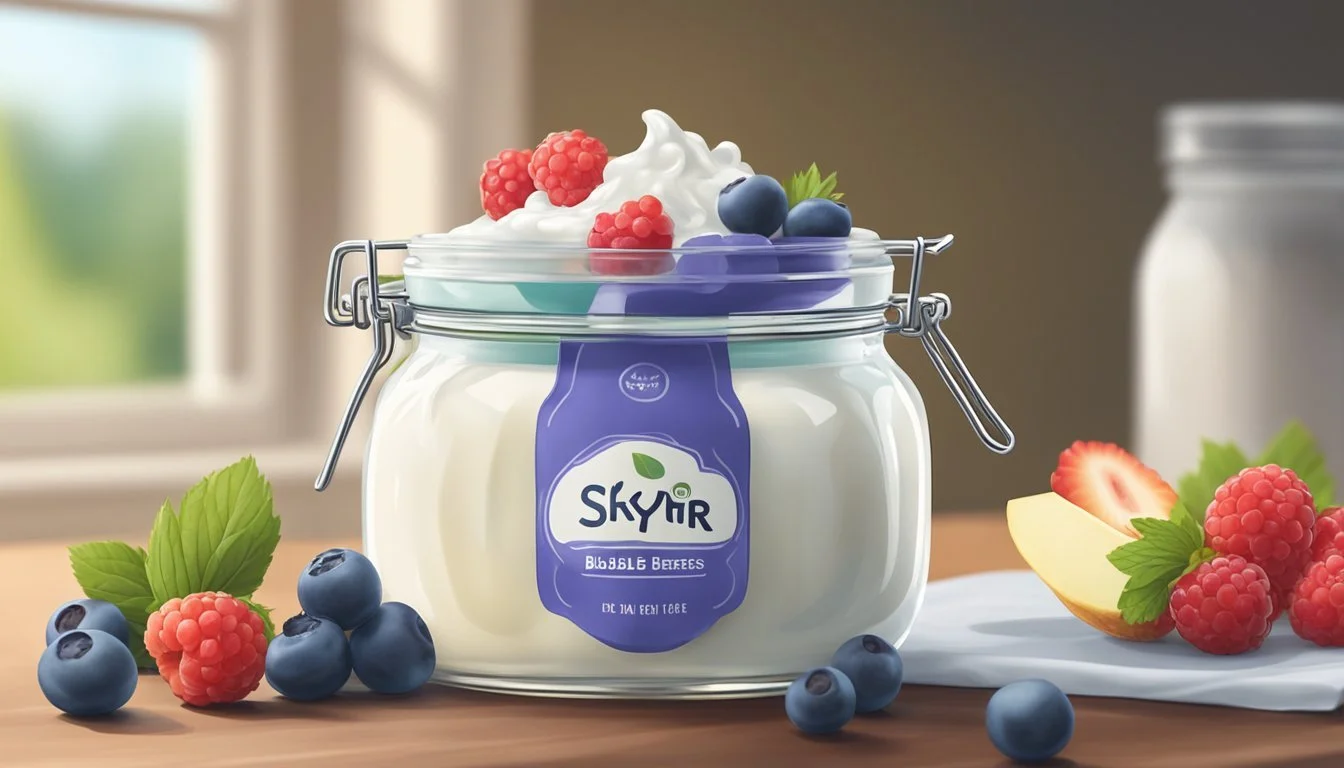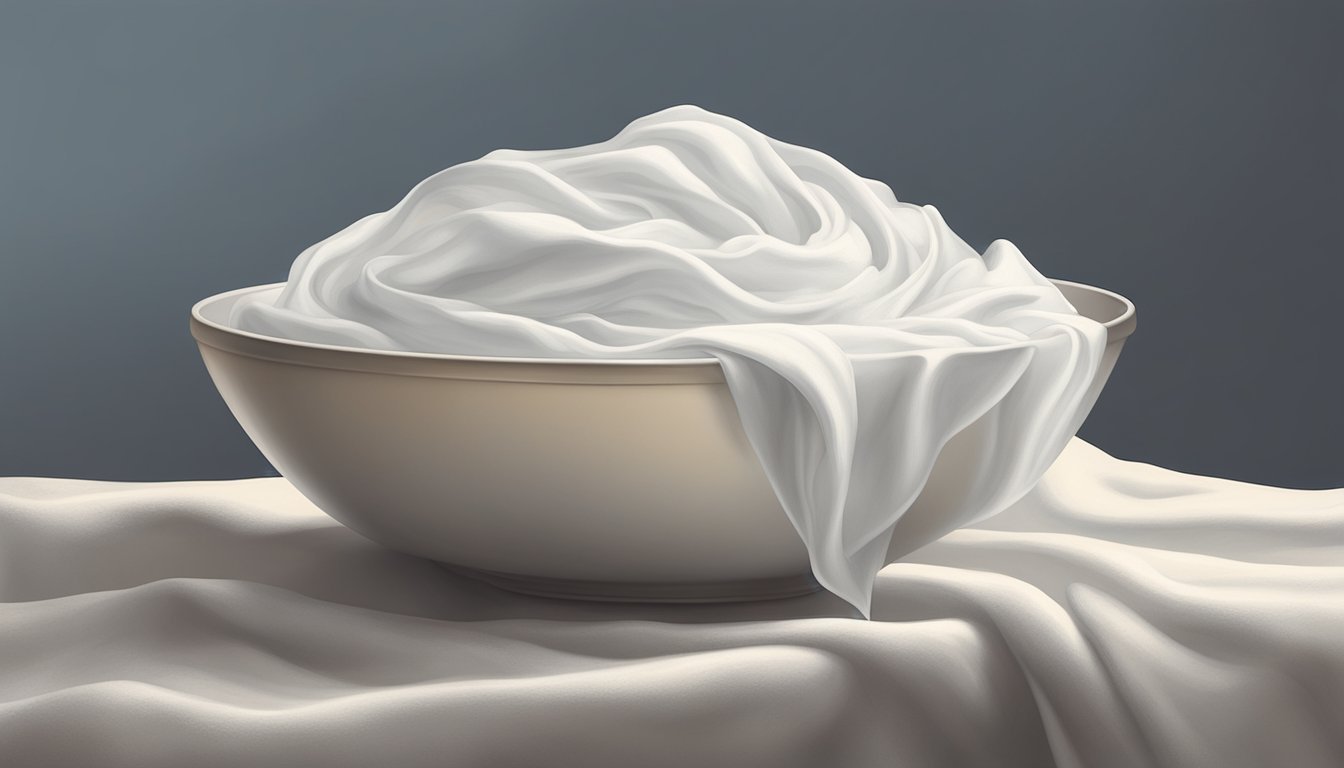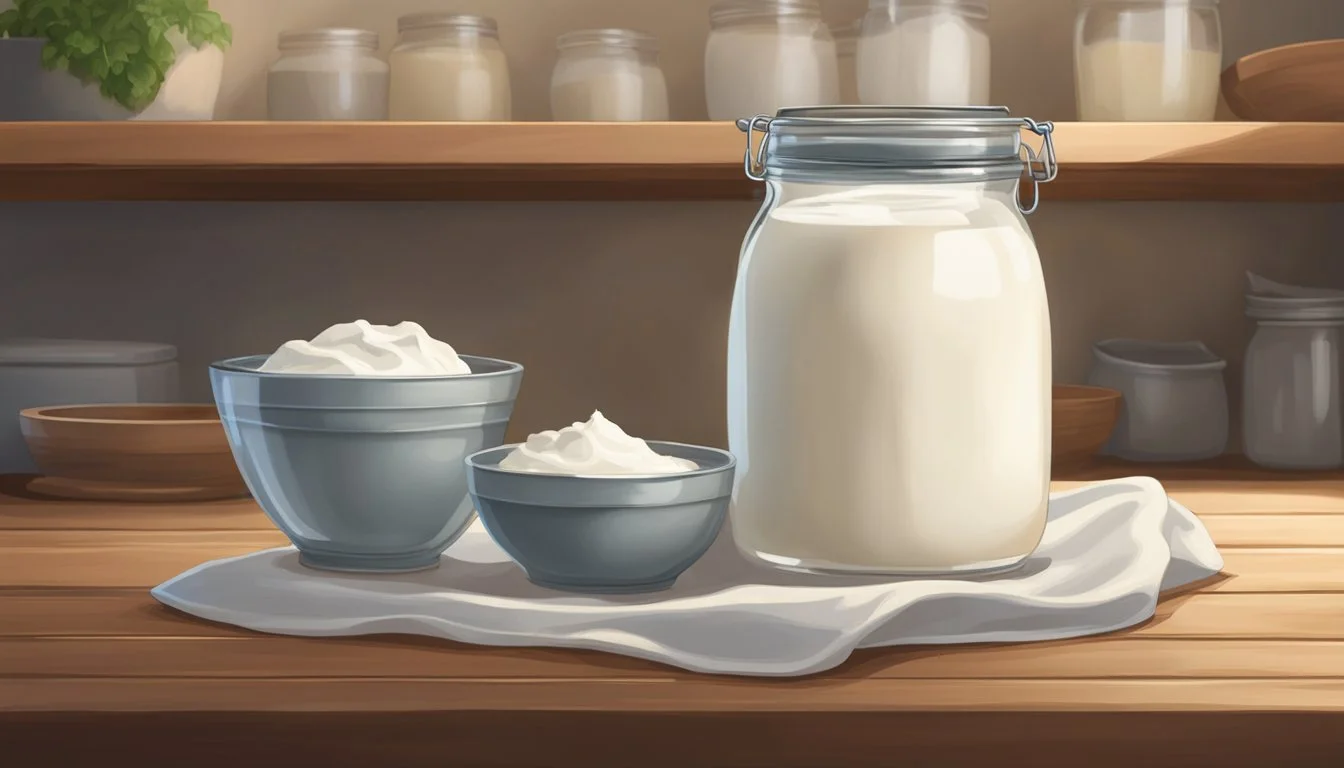How to Ferment Skyr
Mastering Icelandic Dairy Culture at Home
Skyr is a traditional Icelandic cultured dairy product with roots that trace back over a thousand years, showcasing a rich culinary heritage. This creamy staple, similar in appearance to yogurt but in reality a type of fresh sour milk cheese, has been an integral part of Icelandic cuisine since the Viking era. Its unique production process includes fermenting skim milk with specific strains of live cultures, which results in a thick consistency and a distinctly tart flavor that sets it apart from other dairy products.
Making skyr involves a meticulous fermentation process that begins with low-fat or skim milk, which is then warmed and inoculated with live bacterial cultures. These cultures are often derived from previous batches of skyr, ensuring the continuity of its traditional flavor. After the addition of rennet, the milk is left to coagulate and ferment until it thickens, with a texture akin to that of a soft cheese.
As a testament to its nutritional value, skyr boasts a high protein content while being low in fat, making it a favored choice for health-conscious consumers. Beyond its importance as a dietary staple, skyr's revered status in Icelandic culture underscores a sustainable approach to food production, with modern skyr factories in Iceland utilizing carbon-free, hydroelectric or geothermal energy in its creation.
History and Cultural Significance
This section provides an in-depth look at the historical roots of skyr in Iceland, its evolution in modern Icelandic cuisine, and its burgeoning popularity around the globe.
Origins in Iceland
Skyr has been integral to Icelandic culture for over a thousand years, with evidence suggesting its presence since the time of the Viking settlement in the late 9th century. Originally from Scandinavia, this tradition found a stronghold in Iceland, where it became a staple of the Icelandic diet. The National Museum of Iceland chronicles skyr as a sustainably produced food that aligns with the harsh climatic conditions of the region, illustrating its significance in the survival and daily life of early Icelanders.
Skyr in Modern Cuisine
Icelandic skyr has seen a resurgence as a part of the New Nordic Cuisine, emphasizing fresh and local ingredients. Renowned for its creamy texture and high-protein content, skyr is a versatile ingredient in both sweet and savory Icelandic dishes. Icelandic Provisions and Smári Organics are just two examples of producers that have incorporated traditional skyr-making techniques into their products, often found in supermarkets such as Whole Foods, highlighting its role in modern culinary practices.
Global Spread
Skyr's global reach has grown significantly, with availability in supermarkets and specialty food shops far beyond Iceland and Scandinavia. This expansion has been driven by a growing interest in international foods and the nutritional benefits that skyr provides. As a result, it is not only part of the Icelandic diet but is also becoming a familiar item in the kitchens of health-conscious consumers worldwide.
Understanding Skyr
Skyr, a traditional Icelandic dairy product, consistently garners attention for its rich texture and nutritious profile. It is traditionally made from cow’s milk and boasts a unique set of characteristics that differentiate it from other dairy products.
Skyr vs. Other Dairy Products
Skyr is often likened to yogurt, particularly Greek yogurt, due to their similar creamy consistencies and fermentation processes. However, there are distinct differences:
Texture: Skyr has a remarkably thick texture, more akin to cheese than to regular yogurt.
Fat Content: Skyr is traditionally lower in fat compared to other forms of yogurt and cheese.
Preparation: The product is made by fermenting skim milk with specific bacterial cultures that are particular to Iceland.
Table: Skyr vs. Greek Yogurt
Feature: Skyr
Base: Cow's milk
Fat: Lower fat
Texture: Very thick
Protein: Higher protein content
Feature: Greek Yogurt
Base: Traditionally sheep's milk, often cow's milk
Fat: Usually full-fat
Texture: Thick and creamy
Protein: Moderate protein content
Nutritional Profile
Skyr's nutritional value is another important aspect which sets it apart from other cultured dairy products. It is a nutrient-rich food that caters especially to those interested in high-protein, low-fat diets.
Protein: Skyr contains more protein per serving compared to regular yogurt, making it a favorite among vegetarians and those looking to increase their protein intake.
Calcium: Like many dairy products, skyr is also a good source of calcium, supporting bone health.
Fat Content: It is low-fat, aligning well with health-conscious dietary patterns.
Lactose: Skyr may also be well-tolerated by individuals with lactose intolerance, given that the fermentation process reduces lactose levels.
Ingredients and Supplies
To ferment Skyr, one requires specific ingredients and supplies that will contribute to the successful production of this Icelandic dairy product. The type of milk used and the selection of cultures and rennet are crucial in this process. The following subsections detail the appropriate choices for these components.
Choosing the Right Milk
For authentic skyr, skim milk is the base ingredient, as traditional skyr is made after the cream has been removed, resulting in a lower fat content. Full-fat milk can be used for a creamier texture, but skim milk aligns with the traditional Icelandic recipe. The milk should be pasteurized to ensure safety, but not ultra-pasteurized since high heat can affect the milk proteins and hinder the fermentation process.
Possible Milk Choices:
Skim milk: Traditional and low in fat
Full-fat milk: Creamier skyr
Selecting Cultures and Rennet
The cultures used in skyr fermentation typically include a combination of Streptococcus thermophilus and Lactobacillus delbrueckii subspecies bulgaricus. These bacterial cultures are responsible for the tangy flavor and thick consistency of skyr. Skyr also contains probiotics, which are beneficial for gut health.
For coagulation, animal rennet or liquid rennet is used. This enzyme causes the milk to curdle, which is then strained from the whey. Use a small amount of rennet to avoid any bitterness in the final product.
Required Cultures and Rennet:
Bacterial Culture: Streptococcus thermophilus, Lactobacillus delbrueckii subspecies bulgaricus
Rennet: Animal or liquid form, used sparingly
Collecting the ingredients and supplies is a fundamental step in the skyr fermentation process. Ensuring quality and appropriateness of these components will lay the foundation for successful skyr production.
The Fermentation Process
The fermentation process for creating Skyr is meticulous and involves specific steps to ensure the development of its unique thick texture and high protein content. The process begins with preparation and pasteurization, followed by culturing and curdling, and ends with a resting period to achieve the desired consistency and flavor.
Preparation and Pasteurization
Skyr's production begins by heating the milk to kill any harmful bacteria and prepare it for fermentation. Typically, skimmed milk is brought to a high temperature to achieve pasteurization. Following this process, the milk is cooled to the optimal temperature for adding live cultures.
Culturing and Curdling
The pasteurized milk is then inoculated with specific cultures that include strains of Lactobacillus. Additionally, rennet is added to enable the milk to curdle, transforming it into a thick curd cheese. The mixture is maintained at a steady temperature to encourage the fermentation process.
Resting Period
After fermentation, the curds must rest to achieve Skyr's distinctive consistency. During this period, the product is stirred gently to develop a smoother texture. This resting also allows the flavors to mature, resulting in the creamy and slightly tart taste characteristic of traditional Skyr.
Straining and Texturing
After the initial fermentation, Skyr requires careful straining to separate the whey and perfect its creamy texture. This process is crucial to Skyr's final quality, concentrating both the flavor and the protein content that makes this Icelandic staple both delicious and nutritious.
Separating Whey From Curds
To create authentic Skyr, a fine cheesecloth or a clean towel is used for filtration. The whey, a by-product, is gently squeezed out of the curds through this cloth. The objective is to retain as much of the protein-rich curds as possible while eliminating the excess liquid. This is a pivotal step: if too much whey remains, the Skyr will be too thin; if too much is removed, it will be overly thick.
Achieving Desired Consistency
The texture of Skyr is often compared to Greek yogurt but is uniquely thicker. Once the majority of the whey has been strained, one can adjust to their desired consistency. For a creamier Skyr, a small amount of the separated whey can be reintroduced. Here, precision is key. The Skyr should be blended until it reaches a smooth and uniform consistency. Homogeneity in texture is a hallmark of well-made Skyr.
Flavoring and Serving
Skyr, renowned for its versatility, welcomes a variety of flavorings and accompaniments, transforming it from a simple cultured dairy product to a delightful treat suitable for breakfast or dessert.
Adding Sweeteners and Flavors
To enhance the taste of skyr, individuals often incorporate sweeteners and flavors. Sugar and honey are common additions, with honey offering a natural sweetness that complements skyr's tangy profile. Vanilla extract is another favored choice for infusing a warm, rich flavor. For those looking to avoid refined sugars, brown sugar provides a deeper, molasses-like sweetness.
Sweeteners:
White sugar
Brown sugar
Honey
Flavors:
Vanilla (usually extract)
Cinnamon or cardamom (for a spiced twist)
Incorporating Fruit and Berries
Skyr pairs exceptionally well with fruits and berries, elevating its nutritional value and taste. Many opt to fold in fresh fruit such as blueberries, strawberries, or slices of banana. Berries offer a vibrant burst of both color and flavor, making skyr an appealing option for a nutritious breakfast or dessert. Using jam is a convenient alternative for adding fruitiness during off-season months.
Fruit and Berries:
Blueberries (fresh or frozen)
Strawberries (sliced)
Raspberries
Jam (as a fruit substitute or complement)
Serving Suggestions
Skyr is versatile in its use, making a protein-rich breakfast or a smooth dessert base. It can be served plainly or be topped with a variety of nuts and seeds for added texture and nutrients. For a dessert application, it might be layered with granola and fruit to create a parfait, or simply served with a dollop of jam and a sprinkle of nuts.
Breakfast:
Simply topped with nuts and honey
Mixed with granola and fresh fruit
Dessert:
As part of a parfait with layers of skyr, fruit, and granola
Topped with a fruit compote and a dusting of cinnamon
Skyr as an Ingredient
Skyr, a versatile Icelandic dairy product, is notably lower in calories and higher in protein compared to traditional yogurt. Chefs and home cooks alike find its thick texture and tangy flavor beneficial in various culinary applications.
Baking with Skyr
In baking, Skyr can replace ingredients like sour cream or buttermilk to create moist, dense baked goods. Its low-fat content and high-protein levels make it an excellent ingredient in recipes where a tender crumb is desired, such as in cakes or muffins. The substitution not only infuses a distinct flavor but can also reduce the caloric content of baked treats.
For muffins: Use 1 cup of Skyr to replace 1 cup of buttermilk.
For cakes: Substitute half the amount of butter with Skyr for a lighter texture.
Dairy Alternatives in Cooking
Skyr serves as a nutritional and flavorful alternative to cream or mayonnaise in cooking. It's beneficial for those looking to cut down on calories without compromising on creaminess in their dishes. With Skyr, one can enrich soups, make a thick base for porridge, or as a healthier addition to cereals and smoothies.
Porridge: Stir Skyr into warm porridge to boost protein intake.
Smoothies: Blend with fruits for a thick, creamy smoothie.
Skyr-Based Dips and Sauces
Due to its creamy consistency, Skyr is an ideal base for dips and sauces, suitable for any breakfast buffet or appetizer plate. As a dipping sauce, it can be combined with herbs and spices to accompany vegetables or whole-grain pita bread, offering a nutritious option with far fewer calories than standard dips.
Herb Dip: Mix Skyr with dill and garlic for a fresh, tangy dip.
Barbecue Sauce: Combine Skyr with tomato paste and seasoning for a tangy barbecue sauce alternative.
Preservation and Storage
When it comes to preserving skyr, the focus is on maintaining its quality and extending its shelf life while stored. Appropriate refrigeration and proactive measures are crucial for this delicate dairy product.
Refrigeration Best Practices
Refrigeration is essential for skyr to retain its texture, taste, and nutritional value. It should be kept at a constant temperature of 40°F (4°C) or below, which aligns with the safe zone for dairy storage. Users should place skyr in the coldest part of the refrigerator, away from the door where temperatures can fluctuate. The product must be stored in an airtight container to prevent contamination and the absorption of odors.
Extending Shelf Life
Skyr naturally possesses a longer shelf life compared to other dairy products due to its origins and the fermentation process. To extend this further:
Immediately return skyr to the refrigerator after use.
Use clean utensils when serving to prevent the introduction of bacteria.
For unused portions, observe the "best by" date which stores, especially in the U.S., prominently display, ensuring the product is consumed at its peak quality.
Freeze skyr if it cannot be consumed in a timely manner, bearing in mind that freezing might alter its texture. It’s advisable to thaw it in the refrigerator for a day before using.
Health and Dietary Considerations
Skyr, an Icelandic cultured dairy product, has gained popularity due to its favorable nutritional profile, including high protein content and digestive benefits. It stands as a health-conscious choice among various dairy options for those looking to maintain or enhance their well-being.
Protein Content and Muscle Recovery
Skyr is an excellent source of protein, critical for muscle repair and recovery. A single serving contains between 15 to 20 grams of protein, which is higher than traditional yogurt varieties. This makes it particularly beneficial for athletes and individuals engaged in regular physical activity. Protein also aids in maintaining satiety, which can help with weight management.
Digestive Benefits
Probiotics are live bacteria that are beneficial for gut health, and skyr contains these active cultures. Consuming skyr can thus support the digestive system. Additionally, the extensive straining process used in skyr's production removes much of the lactose, making it a potentially suitable option for those with lactose intolerance. Skyr provides vital calcium needed for maintaining strong bones and teeth.
Comparisons with Low-Fat and Non-Dairy Alternatives
Skyr is considered a low-fat dairy product, as it is typically made from skimmed milk. Compared to full-fat dairy, skyr offers the benefits of lower fat content without sacrificing texture or flavor. While it is not a non-dairy alternative, it fits well into a vegetarian diet. Meanwhile, non-dairy alternatives may lack the high levels of protein and probiotics that are naturally found in skyr.
Skyr in the Market
Skyr, an Icelandic cultured dairy product, is experiencing an upscale in the market, especially in health-conscious demographics. Its visibility in grocery stores is increasing, and a variety of brands are making it readily available with diverse offerings and health certifications.
Commercial Brands and Varieties
Several brands have established a presence in the U.S. market, each offering its unique take on the traditional Icelandic skyr. Icelandic Provisions is known for its rich and creamy texture, often featuring traditional and more inventive fruit flavors. Smári Organics differentiates itself by emphasizing its organic ingredients and eco-conscious practices, providing a choice for those preferring organic food products. Another brand, Arla, provides skyr under its line, while Kea Skyr is directly from Iceland, assuring authentic Icelandic taste.
These products can be commonly found in grocery stores ranging from smaller, local shops to national chains. Whole Foods is an example of a major retailer that stocks various skyr brands, frequently including a mixture of imported Icelandic skyr and locally produced options. Consumers have a wide choice, from the classic plain variety to flavored options, with the tangy, creamy texture being a consistent characteristic across brands.
Health Claims and Certifications
The popularity of skyr is bolstered by its nutritional profile, often highlighted in marketing and product packaging. Skyr typically boasts a higher protein content compared to regular yogurt, and brands like Icelandic Provisions and Smári Organics emphasize the low-fat and low-calorie aspects of their products. Additionally, some of these products come with certifications that appeal to various dietary needs and preferences, such as non-GMO, gluten-free, and certifications verifying the absence of artificial preservatives or colors.
In America, the rise in consumer demand for healthier snack options has facilitated the entry of Icelandic skyr into a broad range of diets, making it a popular choice not only for those of Icelandic descent but also for a general audience seeking nutritious food alternatives. Through third-party certifications, brands are ensuring quality and building trust with consumers, contributing to the growth of skyr in the market.
Homemade Skyr Making
Homemade Skyr is a traditional Icelandic cultured dairy product similar to yogurt, but with a distinct taste and thicker consistency. The process involves using specific starter cultures and the coagulation of milk to achieve the desired texture.
Starter Cultures and Consistency
The foundation of any homemade Skyr is the starter culture. Typically, one would need about 2 tablespoons of commercially available Icelandic skyr to inoculate a liter of milk; alternatives like kefir can also be used, but traditionalists prefer skyr for authenticity. Cream is occasionally incorporated for a richer body, though it's not a requirement for traditional recipes.
Consistency Control:
Starter Culture: Icelandic skyr or kefir
Milk: 1-liter skim or whole
Cream: Optional for richness
Heat the chosen milk slowly until it reaches approximately 90-95°C (194-203°F), maintain it for about ten minutes.
Let it cool to 43°C (110°F) before adding the starter culture.
In a separate container, whisk the starter into a cup of cooled milk.
Return the mixture to the rest of the milk, gently stirring.
Rennet is used to assist in coagulation. Dilute the required amount of liquid rennet in cool, non-chlorinated water, then stir it into the milk.
Troubleshooting Common Issues
During the skyr making process, certain issues may arise, affecting the texture and flavor. Here are common problems and their solutions:
Scorching: Ensure even heat distribution and constant temperature when heating the milk. Scorched milk imparts a burnt flavor.
Grainy Texture: This usually happens when the temperature is too high. Stir gently and maintain an even and moderate heat.
Watery Skyr: If the skyr is too thin, additional straining time or increased amount of starter culture can help achieve a thicker curd cheese consistency.
Weak Flavor: For a stronger taste, consider adjusting the amount of starter or fermentation time.
It's important not to rush the process or skimp on quality ingredients. With patience and careful attention to detail, one can produce a delicious homemade skyr.
Cultural Impact of Skyr
Skyr has played a significant role in Icelandic culture, serving not only as a dietary staple but also as a symbol of national heritage. It has bridged the gap between the ancient and the modern in Icelandic society and even garnered international attention for its unique characteristics.
Skyr in the Icelandic Way of Life
Skyr, a traditional Icelandic cultured dairy product, has been an integral part of Icelandic cuisine for over a thousand years. Its presence in Iceland dates back to the Viking era, illustrating its longstanding significance. Traditionally made from cow's milk, skyr formed a vital element of the Icelandic diet, complementing other local foods such as seafood and lamb. In contemporary times, it remains a fixture on Icelandic tables, consumed regularly by locals and often served in households and restaurants across the nation, particularly in the capital city, Reykjavik.
Iceland's dairy farms, which are primarily family-run, contribute significantly to the production of skyr. These farms are a foundational part of the rural economy and maintain cultural practices that have been passed through generations. The distinctive process of making skyr—where the milk is fermented with specific bacterial cultures—creates a thick, protein-rich food that embodies the strength and resilience of Icelandic culture.
International Influence
Skyr's cultural impact is not confined within Iceland's borders but extends internationally, influencing the dairy choices of consumers in Scandinavia, Denmark, Finland, and even Russia. As a testament to its growing popularity, skyr has been successfully marketed abroad as a nutritious alternative to other dairy products due to its high protein and low-fat content. It has captured the fascination of health-conscious shoppers all over the world, appearing on shelves in various forms and flavors, often marketed as an Icelandic or Scandinavian specialty.
The increased demand for skyr globally has not only heightened awareness of Icelandic dietary customs but also bolstered Iceland’s image as a producer of natural and sustainable foods. This international interest has led to a proliferation of skyr-based recipes and products, further embedding it into the fabric of global culinary culture.












